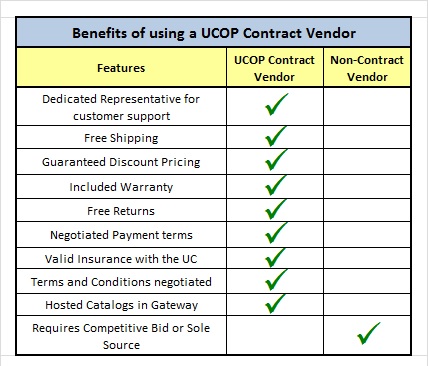You asked for it, you got it!UC Strategic Sourcing has answered your request for a comprehensive listing of Systemwide Supplier Agreements. These currently contracted supplier agreements are available for use by all University of California locations. Check out the UC Procurement Systemwide Contract Listing landing page where you’ll find additional linked pages with listings by commodity category: These contract listings are updated monthly (for ease of access, bookmark the Systemwide Contract Listing landing page). On the main landing page, you’ll also find links to UC & OMNIA Partners competitively-bid contracts and the corresponding contract launch resources in SharePoint: |
|
WEBSITE NAVIGATION |
|
To navigate to these Contract listings from the main UC Procurement website page:
> select ‘FOR UC STAFF’ button:
> Scroll down and select Systemwide Contract Listings menu item (left column):
|
Leveraging UC System

Benefits
Strategic Sourcing benefits your department through savings in money, time, and resources:
- Federal funding agencies encourage the use of state and locally sourced agreements. Using a UCOP Agreement supplier is a valid justification for your purchase as the source selection of the Form A.
- Products and services valued at over $100,000, and purchased through Strategic Sourcing agreements, do not have to go through the competitive bid process, saving time and money
- Gateway, UCSB's online buying site, offers one-stop shopping via online catalogs featuring many of the goods and services negotiated through Strategic Sourcing contracts
- Volume sales, generated when your department buys from Strategic Sourcing suppliers, make it easier for the University to negotiate even better prices when contracts are renewed
- Focuses on the total cost of ownership, not just the purchase price: free shipping, free returns, warranties, and excellent customer service
- These vendors have agreed to, and signed common UC Terms and Conditions to protect us from any unforeseen issues that non-catalog vendors may present, such as no returns, unexpected or high shipping fees, no warranty, distributor fees, etc.
Six Ways
Six Ways - strategic sourcing is different from traditional measures:
- 1. Total Cost, Not Just Purchase Price: From storage to repairs to disposal costs, there is more to a product or service than its sticker price.
- 2. Data Driven Analysis: Strategic sourcing promotes the analysis of data aimed at determining the University’s needs and past purchasing history. Through this data, as opposed to anecdotal information, UC more clearly understands the nature of its businesses and the products and services that it purchases.
- 3. Consolidating Purchasing Power: By leveraging the buying power of all UC locations, strategic sourcing creates strength in negotiating contracts that combine purchases from all locations. These contracts allow UC to get the best combination of pricing, quality of product and service.
- 4. Tighter Supplier Relationships: By narrowing the number of suppliers used in the business, “partnering” in alliances, and entering into mutually beneficial contracts, UC and its suppliers can work together to achieve standardization and improvements in cost, quality, and higher levels of customer-based service.
- 5. Realigned Business Processes: Strategic sourcing redesigns the work and information flow to eliminate redundancies and extraneous tasks.
- 6. Improved Teamwork and Purchasing Skills: Detailed information about products and the buyers’ and sellers’ needs is essential to strategic sourcing. By creating cross-functional teams, a supplier can overcome organizational barriers and inspire
Current Agreements and More Contact Reps
View the UCOP Agreement database. To ask for the UCSB general login, email contracts@bfs.ucsb.edu
View a full list of Fisher Scientific and Alfa Aesar contacts.
View a list of Reps for many (but not all) of our UCOP Contracts, and view a list of Reps for copier vendors.
Fisher Scientific offers several manufacturers - View the Fisher Scientific Supplier Guide.
Environmentally Preferable Purchasing (EPP) and Sustainable Procurement
Sustainable procurement refers to purchasing that takes into account the economic, environmental and socially responsible requirements of an entity’s spending. Sustainable Procurement allows organizations to procure their goods and services in a way that achieves value for money on a whole-life basis in terms of generating benefits not only to the organization, but also to society and the economy, while remaining within the carrying capacity of the environment [Modified from the UK Government’s Sustainable Procurement Task Force (2012)].
The University of California supports the goals of sustainable procurement, including Environmentally Preferable Purchasing (EPP), or the procurement of items that have minimized or reduced environmental effects. It is the intention of the UC to give preference to environmentally preferred products whenever possible.
The University of California Office of the President has included EPP in its Sustainable Practices Policy, including goals and implementation procedures.
Buying EPP products
- Contracted commodities: To stretch your department's dollars and purchase EPP products, take advantage of UC's Strategic Sourcing initiative. Strategic Sourcing requires suppliers to offer products that:
- Include recycled content
- Are energy efficient
- Provide reduced content
- Provide recycle and disposal programs
- Non-contracted commodities: Acquire EPP products by using the following guidelines:
- Develop EPP specifications by creating specific performance expectations and requirements of the product. Consider:
- Why do you need the product?
- How will the product be used?
- Is the product hazardous?
- Is it reusable or durable?
- Is it made from recycled materials? Do we need a new product when the recycled version is just as good?
- What happens to the product at the end of its life? Can it be recycled? Will the manufacturer take the product back? Will the product need special disposal?
- Does it conserve energy or water?
- What is needed to properly maintain and/or operate the product?
- Have the product's environmental attributes been certified by a non-biased, widely-accepted source?
- Search EPP product databases
- Develop EPP specifications by creating specific performance expectations and requirements of the product. Consider:


